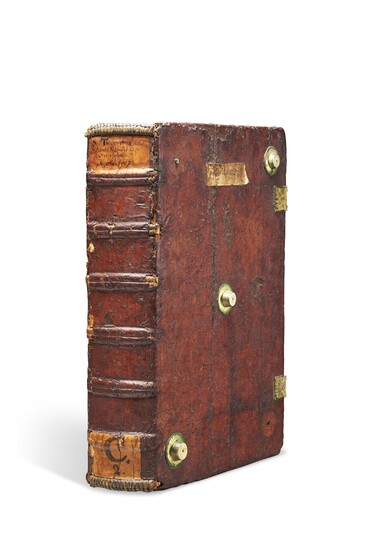Aquinas's Summa theologiae, seconda pars
Aquinas's Summa theologiae, seconda pars
Peter Schoeffer, 1467
THOMAS AQUINAS (c.1225-1274). Summa theologiae, seconda pars. Mainz: Peter Schoeffer, 6 March 1467.
Second edition of Aquinas’s Summa and the first work printed solely by Peter Schoeffer, apprentice of Gutenberg—in a contemporary binding. All the many writings of Saint Thomas Aquinas are preparatory to the great Summa theologiae, which was begun in 1265 and aimed at being the sum of all knowledge. It ranks not only among the most important philosophical works of the medieval Church, but the most important philosophical works ever written. The present edition comprises Part Two of the Summa, the part dedicated to ethics which addresses morality, virtue, and the contemplative life. It was and remains the most widely read section of the larger work, each part of which has a separate printing history. Part Two was the first to be printed (by Mentelin in Strasbourg not after 1463); Part One (Theology) was not printed until c.1469, Part Three (Christ) c.1474; and the compilation of all parts would not appear until over two decades after the first printing of Part Two: in Basel by Michael Wenssler in 1485.
Structured around the scholastic practice of disputatio, the Summa consists of a series of theological questions, followed by arguments pro and contra which explicate Aquinas’s doctrinal views on every issue. Combining authority and argument, Thomas brought his distinctive philosophical outlook to bear on Christian religion, integrating the newly translated works of Aristotle alongside previously developed Platonist conceptions of being and intellect. Art historian Erwin Panofsky famously compared the Summa to a Gothic cathedral, both of which embody "the whole of Christian knowledge, theological, moral, natural, and historical, with everything in its place that which no longer found its place supressed" and are arranged "according to a system of homologous parts and parts of parts."
This edition is the first dated edition of any part of Aquinas's important work, and the first book printed by Schoeffer following the death of his partner, Johann Fust. This copy has Pellechet’s alternate colophon and no printer’s device. Only two other copies of this work are recorded at auction, both of which formerly belonged to Estelle Doheny. H 1459*; BMC I 24; BSB-Ink T-287; Bod-inc T-172; Goff T-209; Pell 1049 (variant); ISTC it00209000.
Royal folio (398 x 286mm). 258 leaves. Green and pink illuminated initial on first leaf, smaller red initials throughout (some pigment losses and soiling to initial, moderate worming in gutter and lower margin, affecting text on the final leaves; a few leaves spotted and occasional dust-soiling). Contemporary calf tooled in blind over wooden boards, clasps, bosses, remains of index tabs, paper labels on upper board and spine (lacking 5 of 10 bosses; boards worn with some losses, some restoration). Provenance: Tachau, convent of Friars Minor (inscription) – acquired from Lathrop C. Harper, Inc, New York, 3 February 1966.
View it on
Sale price
Estimate
Time
Auction House
Aquinas's Summa theologiae, seconda pars
Peter Schoeffer, 1467
THOMAS AQUINAS (c.1225-1274). Summa theologiae, seconda pars. Mainz: Peter Schoeffer, 6 March 1467.
Second edition of Aquinas’s Summa and the first work printed solely by Peter Schoeffer, apprentice of Gutenberg—in a contemporary binding. All the many writings of Saint Thomas Aquinas are preparatory to the great Summa theologiae, which was begun in 1265 and aimed at being the sum of all knowledge. It ranks not only among the most important philosophical works of the medieval Church, but the most important philosophical works ever written. The present edition comprises Part Two of the Summa, the part dedicated to ethics which addresses morality, virtue, and the contemplative life. It was and remains the most widely read section of the larger work, each part of which has a separate printing history. Part Two was the first to be printed (by Mentelin in Strasbourg not after 1463); Part One (Theology) was not printed until c.1469, Part Three (Christ) c.1474; and the compilation of all parts would not appear until over two decades after the first printing of Part Two: in Basel by Michael Wenssler in 1485.
Structured around the scholastic practice of disputatio, the Summa consists of a series of theological questions, followed by arguments pro and contra which explicate Aquinas’s doctrinal views on every issue. Combining authority and argument, Thomas brought his distinctive philosophical outlook to bear on Christian religion, integrating the newly translated works of Aristotle alongside previously developed Platonist conceptions of being and intellect. Art historian Erwin Panofsky famously compared the Summa to a Gothic cathedral, both of which embody "the whole of Christian knowledge, theological, moral, natural, and historical, with everything in its place that which no longer found its place supressed" and are arranged "according to a system of homologous parts and parts of parts."
This edition is the first dated edition of any part of Aquinas's important work, and the first book printed by Schoeffer following the death of his partner, Johann Fust. This copy has Pellechet’s alternate colophon and no printer’s device. Only two other copies of this work are recorded at auction, both of which formerly belonged to Estelle Doheny. H 1459*; BMC I 24; BSB-Ink T-287; Bod-inc T-172; Goff T-209; Pell 1049 (variant); ISTC it00209000.
Royal folio (398 x 286mm). 258 leaves. Green and pink illuminated initial on first leaf, smaller red initials throughout (some pigment losses and soiling to initial, moderate worming in gutter and lower margin, affecting text on the final leaves; a few leaves spotted and occasional dust-soiling). Contemporary calf tooled in blind over wooden boards, clasps, bosses, remains of index tabs, paper labels on upper board and spine (lacking 5 of 10 bosses; boards worn with some losses, some restoration). Provenance: Tachau, convent of Friars Minor (inscription) – acquired from Lathrop C. Harper, Inc, New York, 3 February 1966.



